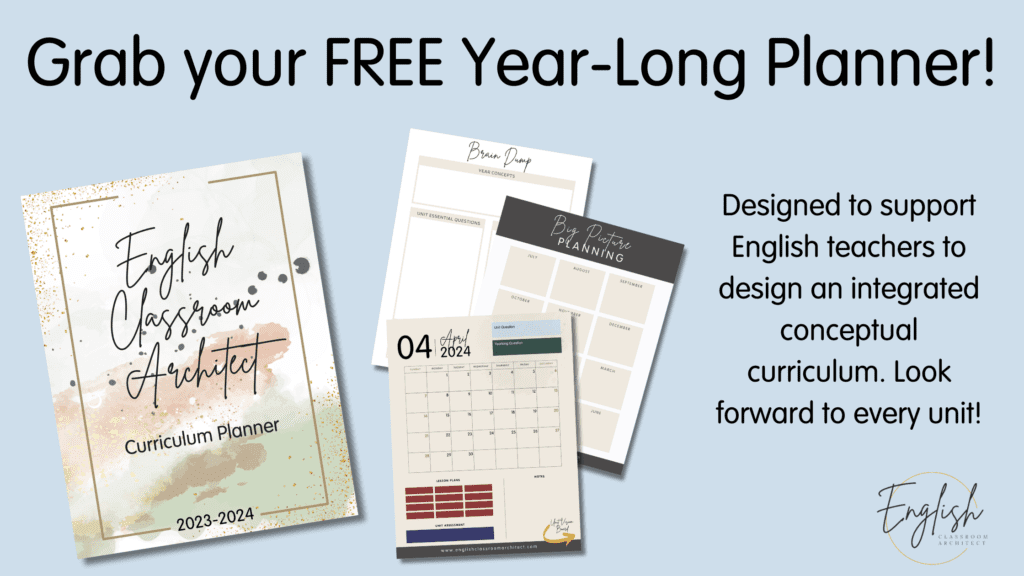Why curriculum planning? As high school English teachers, there are factors stacked against us. More and more students are reliant on summaries or other electronic aids. I’ve found that each year there are fewer and fewer students that have read a book in the past several years. There is a push to make learning practical, and students that lean more to science, math, and technology do not see the value of our content.
I believe this is a messaging error and can be addressed in the ways we shape our curriculum. In this approach to lesson planning, teachers craft a curriculum that leads students to the understanding of how the media we create and consume reflects, challenges, and shapes culture. Not only will spending time on the front end help students better understand the value of our content, but it will also help you feel better. You will feel more prepared and you will significantly ease your time spent planning. If you are wondering what an integrated approach to curriculum planning is, please go back to the first post of this series for more information.
This post is the second of a three-part series. If you are arriving here first, check out Part 1.
Table of Contents

Why to Use an Integrated Approach to Curriculum Planning
As English teachers, one of the most important skill sets we teach our students is how to think about a topic from multiple critical perspectives. This is a heavy ask–this skill contributes to the overall health of our employment population and also our how our government is run. If employees cannot solve problems and think creatively, they risk being replaced. Perhaps more importantly, an informed and critical population is the cornerstone of a well-functioning democracy. The fate of our country is in your hands!
How do we take this responsibility and use it to shape our teaching? Follow below to get started.
Step 1: Craft Your Big Question
As Stephen Covey famously wrote in the Seven Habits of Highly Effective People, if you want to achieve your vision you must “begin with the end in mind.” So, to get started, we will follow backwards planning principles for curriculum planning and start with where we want students to be at the end of the year. The first step to building an integrated and recursive curriculum is to determine what big question you want the students to be able to discuss at the end of the year.
Here are some big questions for teaching an American literature class to get you started:
- How has American culture been shaped by the country’s history, geography, and demographics?
- How does the American media landscape influence public opinion, and what role does it play in shaping the nation’s political discourse?
- How have American cultural values, such as individualism, consumerism, and democracy, evolved over time and been influenced by global events and trends?
- How do issues of race, ethnicity, and diversity impact American society, and how have they shaped the country’s historical narrative?
- How has technology and the digital age transformed American culture, and what are the implications of these changes?
- How does America grapple with the balance between individual freedoms and collective responsibilities?
- How have American cultural exports, such as music, film, and television, influenced global culture, and how have other cultures influenced American culture in return?
- What are the founding principles and values upon which America was built, and how do they shape the nation today?
- What is the relationship between American culture and the natural environment, and how have environmental issues affected and been addressed in American culture?
- How has American culture been shaped by religious, political, and ideological beliefs, and how have these beliefs influenced social and cultural change in the country?
You may notice that my questions are not asking students to directly answer how literature connects to these questions. Of course this will be part of the curriculum, but at this point, challenge yourself to think more broadly.
Step 2: Determine Your Final Assessment
Continuing with crafting your vision of where you want students to be at the end of the year, the next step in your curriculum planning is to think about how you want students to demonstrate their knowledge? You could have students write an essay, complete a project, or simply have a discussion.
I think it’s a good idea to be realistic and consider your energy at the end of the year. I have two ways that I have really enjoyed closing out the year:
- Fishbowl discussions followed by a whole-class Socratic seminar. Students spend the last week or so preparing for the discussions and then the last class period (or two) discussing.
- Great American Novel Project. I introduce the idea that other countries have what they consider a national epic, and that since the beginning of our country authors have aspired to write what would be considered the Great American Novel or epic. I review the criteria (briefly, that it would need to encompass the values and culture of the entire nation). Depending on time, I have students either produce a book trailer or complete a social media campaign for the proposed novel.

You don’t have to create your final assessment at this point, but your future self will thank you if you have something fairly fleshed out.
Step 3: Create Sub-questions
Then, continue your curriculum planning by taking your big question for teaching your course and determine what kinds of conversations students will need to have during the year to give them the fodder to discuss it. This should take the form of sub-questions. Your sub-questions will drive the content of your units.
A Quick Reassurance About This Curriculum Planning Process
I find that if teachers aren’t already uncomfortable with this process, here is where they start to be concerned. In my experience, teachers will begin with the book and build a unit that works for that book, often with several themes woven through. At this point I would like to remind you of our goal: to build an engaging and rigorous curriculum that does not leave us feeling stressed and depleted. This process will lead to a complex, but streamlined curriculum that will feel cohesive to you and to the students. Using the method of determining and using big questions for teaching your course will help you make strong decisions about what to include and ignore as the school year progresses. This clarity will reduce decision fatigue and lead to a happier teaching you. Okay…with that said, back to the regularly scheduled blog post.
Crafting Sub-Questions
Our process for creating sub-questions can be similar to what we ask students to do when we ask them to break down a complex prompt.
A suggested process:
- Determine the main topics of your big question.
- Consider what context students would need to answer the question.
- Consider what connections students might make between topics.
- Write questions for each of the bullets above.
Here are some sub-questions that can help explore the balance between individual freedoms and collective responsibilities in America (question 6 in STEP 1 above):
- What are the core principles and values that underpin individual freedoms in American society?
- How do individual freedoms contribute to personal autonomy and self-expression?
- In what ways do individual freedoms enhance innovation, creativity, and economic growth?
- How have historical events and movements shaped the understanding and protection of individual freedoms in America?
- What are the inherent limitations or boundaries to individual freedoms in the context of collective responsibilities?
- How do collective responsibilities arise from the need for social cohesion, public safety, and the common good?
- What are the moral and ethical considerations involved in balancing individual freedoms and collective responsibilities?
- How do government policies and laws navigate the tension between protecting individual freedoms and promoting collective well-being?
- What are some specific instances where conflicts or controversies have emerged regarding the balance between individual freedoms and collective responsibilities in America?
- How do different perspectives, ideologies, and cultural values influence the ongoing debate surrounding individual freedoms and collective responsibilities?
Now that you have a strong frame for the year, the next step in curriculum planning is constructing the scaffolding. Bby using these questions you determine unit concepts and texts.
Conclusion
Spending time building this frame for your unit is an important step in clarifying your purpose and objectives for the year. Part of finding joy in our work is understanding what we can control. Our pacing guides often determine the skills to cover, but not the concepts, giving us the freedom to help students explore important ideas and teach them not what to think, but how to think about the concepts that are important to our lives.
Now that you have a strong frame for the year, check out the next step in this series of building curriculum to construct the scaffolding to your year by using these questions you determine unit concepts and texts.




